Many gardeners we speak with have never heard of Catalina Currant. It’s not a particularly dazzling or showy shrub, and as such it is an often overlooked plant. It is unlikely to be found in your average run-of-the-mill plant nurseries, but nurseries that specialize in California native plants do frequently offer this species for sale.
Also known as Santa Catalina Island Currant, Island Gooseberry, Catalina Perfume, or Evergreen currant, Catalina Currant (Ribes viburnifolium) has a limited natural range. This species is native to Santa Catalina Island, and parts of Baja, California. However, it is relatively rare in its natural habitat, where it favors growing in shaded canyons and on wooded slopes. The California Native Plant Society lists Ribes viburnifolium as a ‘fairly endangered species’. As such, you are much more likely to encounter this plant in cultivated gardens on the west coast, than in the wild.
Ribes viburnifolium no doubt gets its common name, Catalina Perfume, because the stems and leaves of this shrub are highly aromatic, especially after rainfall. Some liken the aroma to apples, others to pine. Unlike most species of Ribes, the evergreen leaves of Catalina Currant are quite waxy in texture, with relatively minimal veining.
Catalina currant is an arching and sprawling shrub, and is a good ground-cover choice for dry dappled shade. Allowed to grow in its natural form it can be somewhat open and leggy in habit. The graceful, arching, wine-red stems reach 2-3 feet tall, and 8-10 feet in length, but its loose growing habit can also cause it to become overwhelmed with weeds and grasses.

The new growth of Ribes viburnifolium has bright red stems, fading to a rich mahogany or wine-red color with age
If pruned regularly while young, the shrub will take take on a more compact and densely shrubby habit, and this is the form that is typically seen in cultivated gardens. If allowed to grow naturally, keeping the area weed-free while the plants establish themselves is advisable. In winter, with sufficient rains, where the arching stems reach the ground, this shrub will readily root across a bank or slope, making it an excellent choice for erosion control on shaded slopes.
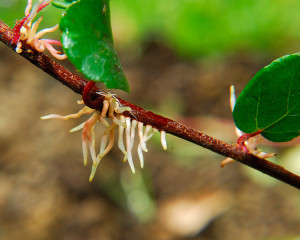
Ribes viburnifolium freely roots along its branches in the presence of sufficient moisture, making this species easy to propagate
Ribes viburnifolium begins to bloom in early spring, continuing through early to mid-April, but has relatively insignificant flowers compared to the more showy native Ribes species, like Ribes malvaceum, and Ribes sanguineum. Catalina Currant sets small clusters of flowers with wine-colored petals, surrounding bright white stamens.
While attractive at close range when in bloom, the flowers are not particularly showy when viewed from afar, however they do provide a nectar source for hummingbirds, bees and butterflies. This makes it a valuable addition to any California garden.
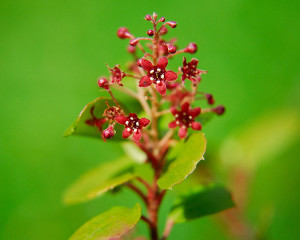
The delicate flowers of Ribes viburnifolium are beautiful when viewed up close, but lack presence from a distance
In cultivated gardens this plant is reported to rarely set fruit. Our plants are still quite young, and thus far have not been pruned. Instead we’re choosing to allow the plants to take on their natural form on a slope at the edge of an area of woodland comprised of a mix of oak, bay, and occasional redwood. Our plants did produce scant fruit last fall, and we’re curious to see if the fruit set improves as the plants become established. The fruits are edible, raw or cooked, and are favored by birds.
Catalina Currant is not particularly cold-hardy, and will suffer leaf-burn and die-back between 10-15 F. In milder climates though, Catalina currant is an excellent plant for dry shade, and as such has tremendous value in west coast gardens for growing beneath oaks, where summer watering is often detrimental to the health of the trees. Catalina currant is exceptionally drought tolerant in clay soils.
Deer tend to leave this plant alone, especially once established, although young tender plants may be vulnerable.
If you have native California oaks on your property, or an area of dry shade where little else will grow, Ribes viburnifolium is definitely worthy of allocating a little space for in your garden.

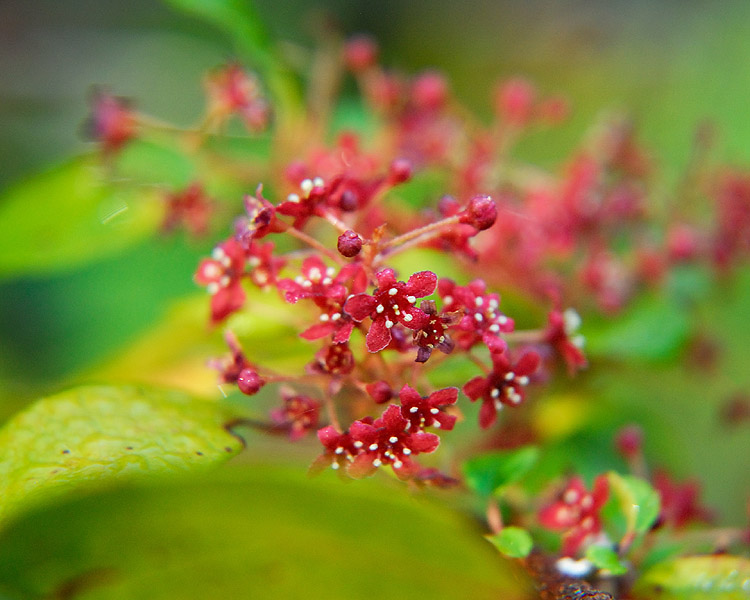


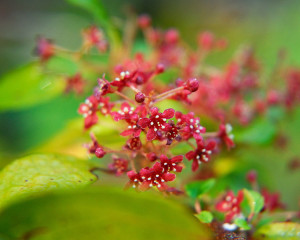
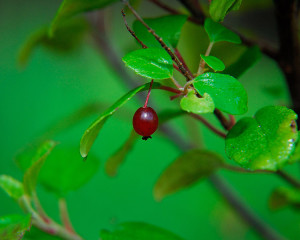







Thanks for showcasing this native, CV. It is lovely and sounds a perfect plant for under those oaks. Hope is gets planted enough to be taken off the endangered list. We worry about all the endangereds.
Frances
.-= Frances´s last blog ..Hellebore Experiment-The Results =-.
Mmmm. You are really starting me thinking. I have this shady area near the fence where A. Howard McMinn is not doing well at all. Maybe in the fall, I’ll try some of these. Amazing photos!
Ahhh you zone 9-10 people post these great plants and make me jealous. I haven’t started on any bramble area yet but have had the thought of incorporating a Gooseberry in it in the back of my head.
.-= Karyl´s last blog ..Native Trees and Shrubs in My Garden =-.
I feel I have learned everything I would need to grow this fruit. I hope it will soon flourish again in the wild for the hummingbirds and bees. Terrific informative post! Your photos too offer both information and beauty. As always well done! Happy Spring! Carol
.-= Carol´s last blog ..First Full Day Of Spring Walkabout Surprising Visitors! =-.
Of course I won’t be able to grow this shrub here, but I can’t see why it isn’t more popular, what with wine-red stems, spectacular rooting ability, and a scent reminiscent of apples and/or pine after rain. It sounds delightful!
.-= Meredith´s last blog ..fluffy =-.
You know Meredith, I think part of the reason is many gardeners don’t know about it. The other is probably that except during bloom, this is one of those basic, boring, green ground-cover plants. However, that said, I’d much rather see this planted, than something like English Ivy. They both tolerate shade, but at least this is native to our region.
I absolutely love Ribes. Such a fantastic plant and not used enough… that’s a nice shot you took of the colorful stem, too.
I wish I could grow this … I love currants. Trust me, you don’t want English Ivy … and if you do, I have plenty to share that I can’t get rid of 🙂
.-= joey´s last blog ..‘SPRING HAS RETURNED…’ ~ CHICKEN SATAY & ASIAN ASPARAGUS =-.
Never heard about it. Looks lovely. I love its red stems especially.
.-= Tatyana´s last blog ..Awakening =-.
Yes, I’d never seen it until Alice posted a picture of it. Thanks for elaborating! I’m actually removing english ivy from beneath an oak and replanting with natives now! Your post is timely as ever!
.-= Christine´s last blog ..A Quick Bit of Ephemera =-.
I love the way this plant grows roots on its woody branches. Thymus serpyllum spreads in the same way in my garden.
.-= melanie´s last blog ..Designing And Building A Perennial Border. =-.
Hey you! Jon pinged Jeff & me this afternoon, and we are wow’ing over your land! A long way from our old trips to the nursery, pulling Haven around in those little red wagons, and piling stuff into the trunks of our cars, eh? Not to mention having to buy only shade-tolerant plants for those tiny gardens under the redwoods in Gold Gulch.
But where are the photos of the land itself? You must post some.
(P.S. Someone said, “Ruh-roh,” just the other night, and Haven said, “That was Claire who used to say that, wasn’t it?” He will be 13 this summer. . .if you can even imagine such a thing.)
.-= Victoria´s last blog ..Being abused by Amazon =-.
Great to hear from you Victoria. Well, with all the hills and valleys around here, it’s a bit tricky getting it all in one photo. Pics of the veggie gardens coming very soon. For a photo of the orchard area near the house, there’s a Google Earth aerial view here:
https://curbstonevalley.com/blog/?p=1545
The land goes off that aerial shot in all directions. Some of it is shaded like Gold Gulch, some of it is open and scorchingly hot in summer. I love having more than one micro-climate on this property. I can grow everything from anemones to hot peppers here!
Ruh-roh is right…Haven can’t be 13…I CAN’T be that old!? 😛
I’m in the group you speak of that has not heard of this particular plant. However, I’m in love with the precious little red blooms with the little yellow centers. And of course the fruit looks yummy! The roots on the stems are interesting too.
.-= kimberly´s last blog ..I Miss Back When… =-.
I wish I could grow that one here! I’ve never heard of this one either. It is quite a bit different from the ribes sanguineum that we grow, although the hummingbirds seems to like both.
.-= Catherine´s last blog ..This is what I love about Spring. =-.
I’m so glad that I found your blog and website. Beautiful!
.-= Stevie´s last blog ..30-minute Mozzarella in Only 2 and a Half Hours =-.
Great photo with the little roots coming off the stem.
I planted two in a shady spot in a garden I was working in. They weren’t irrigated at first and I watered them in on planting them, then again two weeks later, then not again for a month. One of them lost a couple leaves, but other than that they were fine. Tough little guys.
.-= Brad´s last blog ..Calypso bulbosa – Fairy Slipper, a CA native orchid =-.
That last picture of the lone currant is enchanting. I’m tempted to reach in and pick it!
.-= Heidi´s last blog ..Katy Did It! =-.
i use ribes viburnifolium quite a lot in my landscapes. i usually keep it short and dense – great suggestion by the way! on one project, we allowed a row of them to get to about 3′ tall and 3′ wide and it’s formed a perfect little hedge – mostly plain, but very pretty. another reason why it’s not very popular is that it’s pretty slow to establish. they don’t usually grow much for the first year or two and take three years to take off – at least around here – the bay area. but thye are very tough plants though.